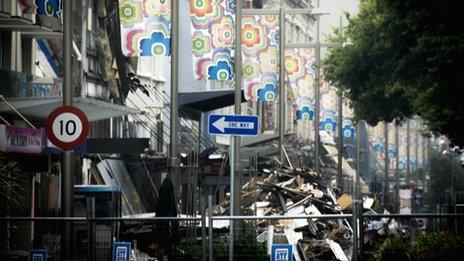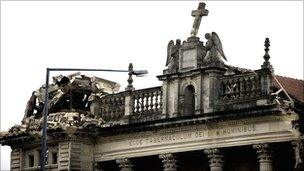Christchurch businesses still hit a year after quake
- Published

The earthquakes have devastated the city
Sunday marks the anniversary of the first major Christchurch earthquake. But the devastated city continues to struggle with daily aftershocks and long-term uncertainty.
When it struck with terrifying force in the early hours of 4 September last year, the 7.1 magnitude earthquake caused extensive damage to New Zealand's second largest city, Christchurch, which is home to more than 350,000 people.
Thousands of homes and businesses were wrecked, including many of the city's famed English heritage buildings.
Remarkably, there were no fatalities.
But the massive 2010 disaster was to be followed by another major earthquake within six months.
On 22 February, a shallow 6.3 magnitude tremor destroyed most of the city's central business district and claimed more than 180 lives.
A lengthy series of frightening jolts and aftershocks continues today, hampering recovery and rebuilding work.
Closed for business
Christchurch represents about 10% of the New Zealand economy. But since the first earthquake, the city's business district has been cordoned off and closed for business.
The only activity now is large-scale demolition work. It could be another six months before construction teams begin rebuilding the city.
Scientists say it could be up to a year before the seismic activity comes to a complete end.
In the meantime, hundreds of shops and business have relocated from the CBD to suburban streets or newly developed business parks.
One of the many central city businesses forced to relocate is local law firm Wynn Williams. "Prior to the earthquake, we were located in the heart of the CBD," says Jonathan Gillard, a senior partner with the firm.
"Following the February earthquake, our firm, along with 55,000 other central city business workers, had to find a new home.
"We have taken temporary premises for three years on the outskirts of the city in a new shopping centre owned by one of our clients," Mr Gillard says.
"We were one of the lucky businesses that were able to secure alternative premises for our staff that is new and safe," he adds.
Wynn Williams intends to return to the central business district as soon as possible. But others have left the city completely. Some have moved homes and business overseas.
Those who remained in the city have endured more than 8,500 aftershocks, including several strong shakes just last week. Two days before the anniversary, Christchurch residents were shaken from their beds by a 4.9 magnitude aftershock.
Costly repairs
The country has also been rocked by news of an escalating repair bill.
New Zealand's Earthquake Commission (EQC) is the government agency providing natural disaster insurance for homeowners. The EQC pays the first 100,000 New Zealand dollars of repairs and private insurers pay anything over this amount.
But the government recently revealed it had underestimated the EQC's liability. The total cost to the EQC could be more than double the original estimate, jumping to 7.1bn New Zealand dollars ($6.1bn).
This new estimate is expected to push the government's deficit to a record NZ$18bn.
The EQC is now dealing with nearly 600,000 separate claims for land, building or contents. This puts the disaster in Christchurch on a similar scale to the devastation that struck the southern American states during Hurricane Katrina - the total rebuild could cost up to NZ$30bn.
'Aggressive' demolition
About 10,000 houses and nearly 1,000 commercial buildings will have to be demolished as a result of the devastating quake in February.
One positive outcome is the building boom that will eventually follow.
But while money will soon flow into the region, the biggest losers are global insurers.
For them, these earthquakes are among the world's most costly natural disasters.
And while seismic activity continues, so does the debate about how and when the rebuilding can begin.
Christchurch City Council recently released an ambitious plan aimed at relaunching the central city.
The NZ$2bn proposal recommends a sustainable hi-tech city, featuring a new light rail transport system and low-rise buildings.
But some experts say the demolition of damaged heritage buildings has been too aggressive.

Some say buildings should be repaired rather than knocked down
Dr Kit Miyamoto, a visiting earthquake engineer from Japan, told the Christchurch Press newspaper he was shocked by the eagerness to bulldoze the city.
He warned the demolition work could derail plans to revitalise the city.
"Even in Haiti, where I have spent a lot of time, only 20% of the buildings have come down. It is a very high number in Christchurch," he said.
"A lot of buildings should be considered for repairs and strengthening, particularly heritage buildings."
By demolishing so many buildings, much of the central city would become a big vacant lot, making it very difficult to attract fresh capital to rebuild, he said.
How long the rebuilding of Christchurch will take is still unclear.
According to the authorities, damage to infrastructure will take up to five years to repair.
While the waiting - and shaking - continues, there is anger as well as optimism on the streets of Christchurch.
- Published23 August 2011
- Published11 August 2011
- Published23 June 2011